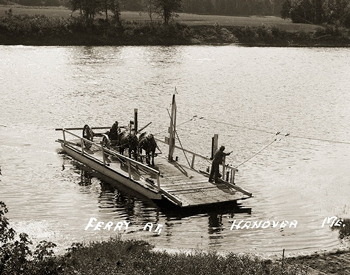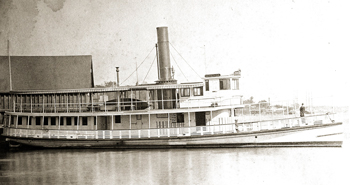Maine Ferries
by Tom Seymour

Before bridges were common, ferries were and most were on rivers. Some might simply be a row boat that carried a few passengers, a sheep and chickens. The earliest more commercial ferries in Maine were barges pulled across rivers with a rope and kept from being drawn down stream by a taught rope across the current. Photo courtesy of Penobscot Maritime Museum.
In the late 18th century and well into the 19th century, water travel was a common mode of transportation. Residents of Maine’s coastal communities were often obliged to avail themselves of whatever conveyance was available in order to get from one part of town to the other and this included various types of watercraft. In those early days, everything from scows to dories served as makeshift ferries.
Belfast Ferries
For instance, in Belfast, Tolford Dunham from the east side (of the Passagassawaukeag River) and James Miller from the west side served as “ferrymen.” The ferries they used were dugout canoes made by hollowing out huge logs with an adze. Dunham and Miller did this on a volunteer basis and rarely received pay for their efforts.
Then in 1794 towns were compelled to provide ferry service by the Court of Sessions. Somehow, Dunham and Miller, despite their years of service, were passed over by the City of Belfast and Ephriam McKeen was awarded the right to operate a ferry.
Two years later, General Henry Knox and his guest, the visiting Duke de Liancourt visited Belfast and were obliged to cross on the ferry. Liancourt wrote that he and General Knox waited an hour for the ferry. “The ferry was small,” Liancourt wrote, “and for our horses very inconvenient.”
In 1805 Daniel Hibbard was the official Belfast ferryman. Hibbard charged fourpence per person and four times that for each horse.
Then in 1830 the Court of Sessions appointed James Langworthy as ferryman. Langworthy was directed to keep his boats available around-the-clock. The court authorized Langworthy to impose a toll of three cents per person.

By the mid 1800’s steam-powered ferry boats were common on longer passages up and down rivers, but across bays and to offshore islands. This late 1800’s example, the Sebenoa, sailed in and around the islands of Frenchmen’s Bay. Diesel-powered steel versions ply the same waters today.Photo courtesy of Penobscot Maritime Museum.
Prospect Ferries
A little further up the coast from Belfast, the Town of Prospect lies across the Penobscot River from Bucksport. And Bucksport was where people from Prospect needed to go for supplies.
In the early days, ferries were a catch-as-catch-can operation, but in 1807, according to Alice Verrill Ellis in her book, The History of Prospect Maine 1759 to 1979, the first regular ferry service for Prospect was instituted in 1807. The “ferry” was a scow owned by Mr. Whitman and Mr. Towle. Then in 1820, Col. John Lee purchased ferry rights and imposed a toll of 25 cents per person or per animal.
After Lee’s retirement, his son operated the ferry and Andrew Bennett, his scow captain, fashioned a paddle wheel for the scow. This wheel was attached to a horse-operated treadmill by means of a shaft. This contraption was fairly efficient, except that it proved problematic in winter when equipment froze, so then the ferry was sculled by manpower. It seems likely that Lee and Bennett’s horse-powered ferry was the most unique of all of Maine’s old-time ferries.
Ferries Today
As roads developed and a growing population increased the demand for safe and efficient ferries, more modern vessels were employed for ferry service. From steam to diesel, Maine ferries grew larger and more able to accommodate not only foot passengers but also automobiles. All of these ferries were privately operated. And then in 1957 an act was passed designating the Maine Department of Transportation as administrator of the Maine State Ferry System. Today, this system serves communities up and down the coast, offering ferry service to the inhabited offshore islands.
Much of today’s traffic consists of children going to and from school, delivery vehicles, workmen and contractors and island people going to the mainland. The ferry system also brings mail to the islands, via a subcontractor. But in summer and through fall, walk-on passengers and summer visitors add their numbers to those going on Maine’s ferries. Many ferries add extra trips in summer in order to accommodate increased passenger traffic.
But in with all those other people traveling on ferries, we have another type of passenger, people riding the ferry for a quick ocean-sightseeing trip and a short visit to an offshore island. The Maine State Ferry System now offers special ferry excursion tickets to five different islands in Penobscot Bay. These are Swan’s Island, Frenchboro, Vinalhaven, North Haven and Islesboro.

Early 1970’s island ferry out of Eastport, Maine. Slower speeds, shorter trips and simpler accommodations–the passenger’s vehicles–than some of the ferries out of Rockland, they were none the less relied upon. A version of this side-powered arrangement is still in use today across Passamaquody Bay. Photo courtesy of Penobscot Maritime Museum.
Ferry Trip
For people who have yet to take a trip on an ocean-going vessel, a ferry excursion seems made to order. Although inexpensive, the trip offers a glimpse into a different world. Life on Maine’s offshore islands is a little more laid-back than on the mainland.
So while an excursion passenger’s stay on any one island is limited, it provides ample time for visitors to get a feel for life on an offshore island.
Excursion passengers usually have several options as to where they will pass their time during the trip. Ferries have a main seating section, where comfortable seating offers close-up views of distant shores as well as a number of sea creatures. Marine mammals such as dolphins and seals are relatively common sights, as are marine birds. As the ferry slows down prior to entering the slip at Vinalhaven, passengers are treated to flocks of black guillemots, pigeon-sized birds belonging in the Alcid family and are the Maine equivalent of penguins.
From the upstairs passenger area the visitor gets a direct, open-air view of not only the distant mainland but also closer island surroundings. Given the superlative scenery visible from Maine’s offshore islands, visitors should definitely bring a camera.
